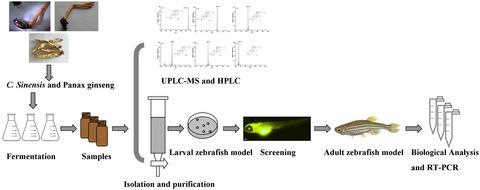当前位置:
X-MOL 学术
›
J. Food Biochem.
›
论文详情
Our official English website, www.x-mol.net, welcomes your
feedback! (Note: you will need to create a separate account there.)
Biotransformation of ginsenoside Rb1 with wild Cordyceps sinensis and Ascomycota sp. and its antihyperlipidemic effects on the diet-induced cholesterol of zebrafish.
Journal of Food Biochemistry ( IF 3.5 ) Pub Date : 2020-03-23 , DOI: 10.1111/jfbc.13192 Fei Li 1, 2 , Zhaoxia Wu 1 , Xin Sui 2
Journal of Food Biochemistry ( IF 3.5 ) Pub Date : 2020-03-23 , DOI: 10.1111/jfbc.13192 Fei Li 1, 2 , Zhaoxia Wu 1 , Xin Sui 2
Affiliation

|
Biotransformation major ginsenoside into minor ginsenoside via microbial fermentation has been proposed as a viable option to produce minor ginsenoside, because of its biological activity superior to major ginsenoside. Cordyceps sinensis contains a complex enzymatic system and many ingredients with medicinal value that could be useful tools for biotransformation applications in the ginseng industry. Wild C. sinensis and Ascomycota sp. were collected from Changbai Mountain and identified. Analysis by UPLC‐MS and HPLC indicates that the underlying pathway of major ginsenoside Rb1 during fermentation with strains was Rb1→Rd→F2→CK and Rb1→Rd→Rg3. C. sinensis and Ascomycota sp. can be applied to minor ginsenoside preparation in the food and medical industries. The antihyperlipidemic effects of Rb1 were further screened from fermentation in larvae zebrafish based on the fluorescence intensity. In the adult zebrafish model, treatment with high‐dose ginsenoside Rb1 group exhibited a significant decrease in the plasma total cholesterol (TC) and triglyceride (TG) levels by 36.49% (p < .05) and 29.97% (p < .05), respectively, compared with high cholesterol group (HC). Furthermore, ginsenoside Rb1 treatment decreased the mRNA levels of LDLR and SREBP2 in the adult zebrafish liver. Ginsenoside Rb1 diet supplement significantly increased the mRNA expression of HMGCR and CYP7A1. These results suggest that ginsenoside Rb1 attenuates hypercholesterolemia via the downregulation of cholesterol synthesis and assembly or secretion of lipoproteins as well as the upregulation of cholesterol transport and efflux, providing a novel idea of ginsenoside keeping cholesterol levels down for the clinical application.
中文翻译:

人参皂甙Rb1与野生冬虫夏草和子囊菌的生物转化。及其抗高脂血症对饮食诱导的斑马鱼胆固醇的影响。
已经提出通过微生物发酵将主要人参皂苷生物转化为次要人参皂苷是生产次要人参皂苷的可行选择,因为其生物活性优于主要人参皂苷。冬虫夏草含有复杂的酶系统和许多具有药用价值的成分,可能是人参工业中生物转化应用的有用工具。野生中华。和子囊菌 从长白山收集并鉴定。通过UPLC-MS和HPLC分析表明,人参皂苷Rb1在菌株发酵过程中的潜在途径为Rb1→Rd→F2→CK和Rb1→Rd→Rg3。中华和子囊sp。可用于食品和医疗行业中的少量人参皂甙制剂。根据荧光强度,进一步从幼虫斑马鱼的发酵中筛选了Rb1的降血脂作用。在成年斑马鱼模型中,高剂量人参皂甙Rb1组的治疗显示血浆总胆固醇(TC)和甘油三酸酯(TG)水平显着降低36.49%(p <.05)和29.97%(p <.05)分别与高胆固醇组(HC)相比。此外,人参皂苷Rb1处理降低了成年斑马鱼肝脏中LDLR和SREBP2的mRNA水平。人参皂甙Rb1饮食补充剂显着增加HMGCR和CYP7A1的mRNA表达。这些结果表明人参皂苷Rb1通过下调胆固醇合成和组装或分泌脂蛋白以及上调胆固醇转运和外排来减轻高胆固醇血症,为人参皂苷提供了一种降低胆固醇水平的新思路,可用于临床。
更新日期:2020-03-23
中文翻译:

人参皂甙Rb1与野生冬虫夏草和子囊菌的生物转化。及其抗高脂血症对饮食诱导的斑马鱼胆固醇的影响。
已经提出通过微生物发酵将主要人参皂苷生物转化为次要人参皂苷是生产次要人参皂苷的可行选择,因为其生物活性优于主要人参皂苷。冬虫夏草含有复杂的酶系统和许多具有药用价值的成分,可能是人参工业中生物转化应用的有用工具。野生中华。和子囊菌 从长白山收集并鉴定。通过UPLC-MS和HPLC分析表明,人参皂苷Rb1在菌株发酵过程中的潜在途径为Rb1→Rd→F2→CK和Rb1→Rd→Rg3。中华和子囊sp。可用于食品和医疗行业中的少量人参皂甙制剂。根据荧光强度,进一步从幼虫斑马鱼的发酵中筛选了Rb1的降血脂作用。在成年斑马鱼模型中,高剂量人参皂甙Rb1组的治疗显示血浆总胆固醇(TC)和甘油三酸酯(TG)水平显着降低36.49%(p <.05)和29.97%(p <.05)分别与高胆固醇组(HC)相比。此外,人参皂苷Rb1处理降低了成年斑马鱼肝脏中LDLR和SREBP2的mRNA水平。人参皂甙Rb1饮食补充剂显着增加HMGCR和CYP7A1的mRNA表达。这些结果表明人参皂苷Rb1通过下调胆固醇合成和组装或分泌脂蛋白以及上调胆固醇转运和外排来减轻高胆固醇血症,为人参皂苷提供了一种降低胆固醇水平的新思路,可用于临床。









































 京公网安备 11010802027423号
京公网安备 11010802027423号